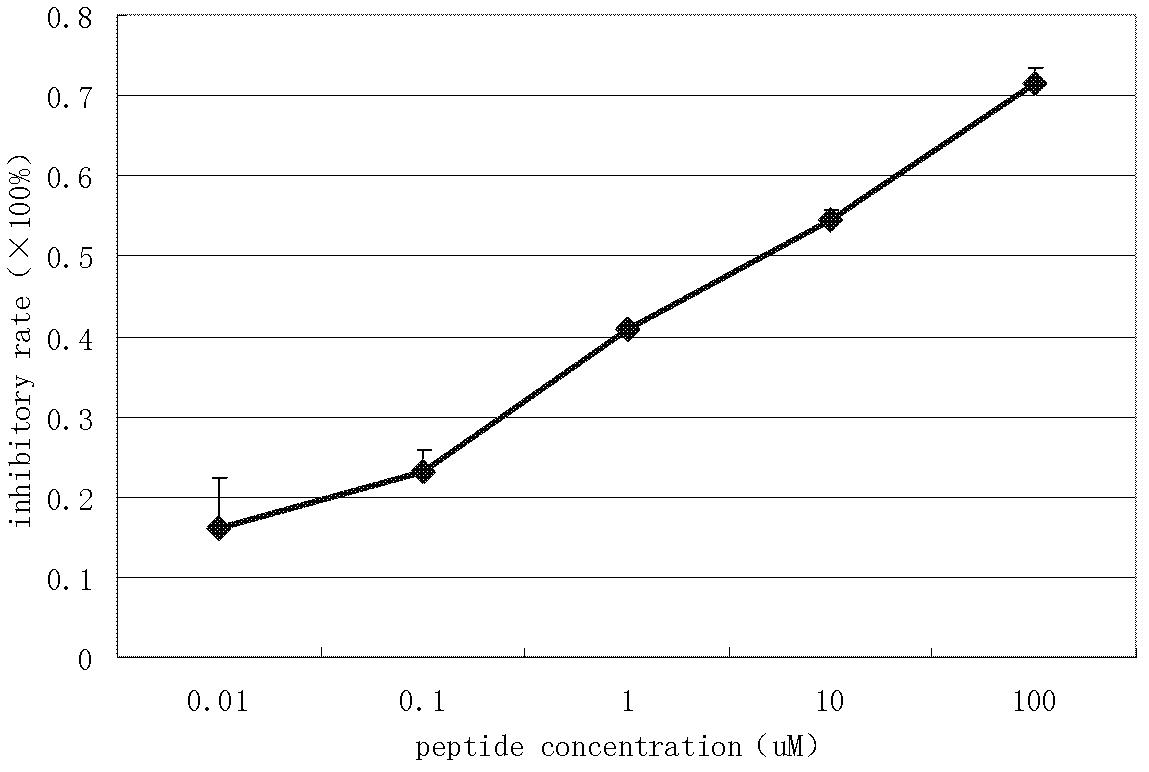Pc-E polypeptide inhibiting aspergillus fumigatus from adhering to cornea
A technology for Aspergillus fumigatus and cornea, which is applied in the field of polypeptides that inhibit the adhesion of Aspergillus fumigatus to cornea, can solve the problem that the specific mechanism of adhesion of corneal epithelial cells is not very clear.
- Summary
- Abstract
- Description
- Claims
- Application Information
AI Technical Summary
Problems solved by technology
Method used
Image
Examples
Embodiment 1
[0030] Example 1: Screening for polypeptides that inhibit Aspergillus fumigatus from adhering to the cornea
[0031] 1) Human corneal epithelial cells (HCEC) cultured to a monolayer were mixed with 10 10 The pfu phage-displayed 12-peptide library (product of New England Biolabs, a 12-amino-acid-long random peptide embedded in the pIII protein of M13 phage) was incubated at 37°C for 1 hr, unbound phages were washed away with PBS, and the glycine eluent was eluted. The phages bound to the surface of HCECs were amplified and titrated, and then subjected to the same two rounds of panning, and finally 14 polypeptides of phages capable of binding to HCECs were obtained. A single phage clone was picked for sequence determination, and the obtained nucleotide sequence of SEQ ID NO: 2 (AGCACGCGTAGGATTAGGAAACGGCGACTCCGCATG) was translated into a polypeptide whose amino acid sequence was SEQ ID NO: 1 (YALRPGMPQWLE).
[0032] 2) Artificial synthesis and identification of polypeptide fragm...
Embodiment 2
[0051] Embodiment 2: the preparation of complete antigen:
[0052] (1) Dissolving the Pc-E polypeptide described in the present invention in dimethyl sulfoxide (DMSO) is prepared into a 0.1 μg / μL polypeptide mother solution; water-soluble carbodiimide (EDC), N-hydroxysuccinyl Imine (NHS) and ovalbumin (OVA) were prepared with 0.01M phosphate buffered saline (PBS, pH7.5) to make 1mg / mL working solution respectively;
[0053] (2) Take 100 μL of polypeptide mother solution, add 20 μL of EDC working solution and 12 μL of NHS working solution, the molar ratio of STX, EDC, and NHS is 1:2-3:1-2, shake and react at room temperature for 3 hours, and obtain the initial reaction solution;
[0054] (3) Prepare the protein carrier with 0.01M phosphate buffered saline (PBS, pH7.5) to make a 1mg / mL working solution.
[0055] (4) The optimal molar ratio of STX and carrier protein reaction is 10:1; add the reactants in step (2) to 100 μL of carrier protein working solution, shake and react at...
Embodiment 3
[0059] Example 3: Preparation of Composite Polypeptide Eye Drops and Detection of Its Effect on Prevention and Treatment of Aspergillus Fumigatus Infection
[0060] Take a certain amount of Pc-E polypeptide freeze-dried powder and dissolve it in borate buffer, a common solvent for eye drops, to prepare eye drops with a polypeptide concentration of 0.1%, and use sodium bicarbonate to adjust the pH value to 5.5-7.5. Glucose adjusts the osmotic pressure to 270-310mOsm / kg, making it meet the standard of conventional eye drops.
[0061] 1 hr before infection, the healthy BALB / c mice were instilled with compound polypeptide eye drops, 15 min / time, for 5 consecutive times, and then the Aspergillus fumigatus (10 7 cfu) infected mouse model, continue to use compound polypeptide eye drops for prevention and treatment after infection, 15min / time, 5 times in a row, remove the cornea after 8hr, homogenate and lyse, then gradient dilution plate counting, only infection without compound poly...
PUM
| Property | Measurement | Unit |
|---|---|---|
| control rate | aaaaa | aaaaa |
Abstract
Description
Claims
Application Information
 Login to View More
Login to View More - R&D
- Intellectual Property
- Life Sciences
- Materials
- Tech Scout
- Unparalleled Data Quality
- Higher Quality Content
- 60% Fewer Hallucinations
Browse by: Latest US Patents, China's latest patents, Technical Efficacy Thesaurus, Application Domain, Technology Topic, Popular Technical Reports.
© 2025 PatSnap. All rights reserved.Legal|Privacy policy|Modern Slavery Act Transparency Statement|Sitemap|About US| Contact US: help@patsnap.com



